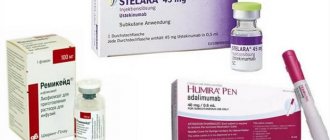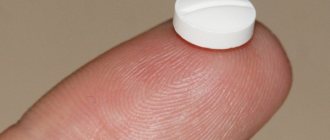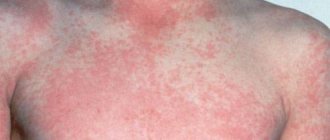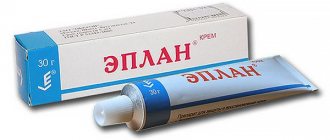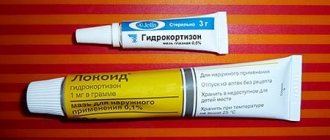Allergy pills that do not cause drowsiness are a new generation of medicines and are an undoubted achievement of pharmacology in the treatment of this common disease. It is no secret that medications have long been quite effective in combating allergic reactions, but unpleasant and sometimes dangerous side effects often occur. Modern, improved antiallergic drugs are free from such effects, and therefore can be safely used to treat children and even pregnant women.
Classification of antihistamines, their generations
There is no generally accepted classification characterizing antiallergic drugs. According to the characteristics of their chemical structure, antihistamines are divided into several groups.
By derivatives:
- piperazine;
- piperisine;
- phenothiazine;
- alphacarboline;
- quinuclidine;
- alkylamine;
- ethanolamine;
- ethylenediamine.
In clinical practice, a classification of antiallergic drugs by generation is used.
Group I includes:
- cyproheptadine;
- quifenadine;
- promethazine;
- mebhydrolin;
- chloropyramine;
- clemastine;
- doxylamine;
- diphenhydramine.
Drugs belonging to the 2nd generation:
- bamipin;
- cetirizine;
- loratadine;
- azelastine;
- terfenadine;
- dimethindene;
- acrivastine.
III generation of antihistamines:
- levocetirizine;
- desloratodine;
- fexofenadine.

Medicines belonging to the first generation have a pronounced sedative effect.
Why do antiallergy drugs make you feel drowsy?
Antiallergic drugs that do not cause drowsiness can be purchased at the pharmacy. Their list is systematically updated. Drowsiness is a side effect of most first generation antihistamines. Medicines in this category are called sedatives.
The mechanism of their action is based on interaction not only with histamine receptors, but also with many others. Drowsiness when taking antiallergic medications occurs due to repeated doses of the drug during the day.
The therapeutic effect from them occurs quickly, but has a short-term effect. With short-term use of first generation antihistamines, the patient develops addiction. Previous medications stop working, and the patient is forced to change the drug every 25-30 days and try some new remedy.
Medicines with a pronounced sedative effect are not recommended for people whose work activity involves driving a vehicle.
Expensive or cheap, is there a difference?
Cheap analogs of allergy medications usually have more side effects and do not always cope with the symptoms of the disease.
Most of them provoke drowsiness and disturbances in the functioning of the cardiovascular system.
Analogues differ from expensive drugs in the degree of purification, which is why their use causes negative health consequences.
More advanced products are slightly more expensive, but they do not have as many side effects.
Also, expensive medications are usually made more convenient to use and have a long shelf life.
In addition, such drugs need to be taken less often, which is also very convenient for the patient.
What drugs do not cause drowsiness and addiction?
Antiallergic drugs that do not cause drowsiness are classified as third (new) generation antihistamines. These are more advanced means that stimulate the process of blocking H1 receptors.
Medicines in this category are responsible for relieving characteristic allergy symptoms. H1 receptors are located in the brain, smooth muscle tissue and blood.
Histamine is responsible for regulating digestive processes. The level of saturation of the human body with food is under its control. The organic compound is also responsible for thermoregulation and ensuring proper rest of the brain during sleep. Antihistamines, which do not cause drowsiness, stop the release of histamine into cells.
Top best new generation allergy medications that do not cause drowsiness
Antiallergic drugs that do not cause drowsiness are safe for the human body, do not cause addiction and quickly relieve characteristic symptoms. People prone to hyperreactions need to remember that drugs in this category are not able to cure the disease: with their help you can only improve your well-being.
Tsetrin
The new generation antiallergic drug Cetrin does not cause drowsiness or addiction even with long-term use. The composition contains active (main) and additional components. The active ingredients are cetirizine in the form of hydrochloride (concentration no more than 10 mg).
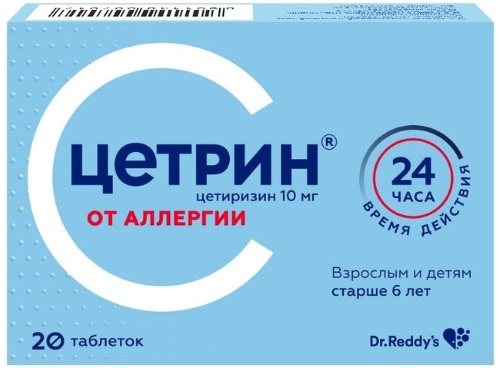
Tsetrin
Auxiliary elements include:
- vegetable starch;
- milk sugar;
- polyvinylpyrrolidone;
- magnesium salts of stearic acid.
Release form:
- round, enteric-coated tablets, convex on both sides (white or yellowish-white);
- transparent, sweet suspension with a fruity aroma (the dosage form does not contain foreign particles).
Cetirizine is responsible for selective blocking of histamine receptors. With regular use, it has an antipruritic and antiexudative effect. There are no antiserotonin and anticholinergic effects.
Indications for use prescribed in the instructions:
- dermatitis;
- neurodermatitis of allergic type;
- hives;
- angioedema;
- allergic rhinitis;
- hay fever
The drug has a number of relative and absolute restrictions on its use.
Category I includes:
- kidney and liver dysfunction;
- elderly age;
- childhood.
An absolute contraindication is considered intolerance to the components present in the composition of the drug. Side effects occur rarely, most often due to non-compliance with medical prescriptions.
These include:
- dizziness;
- headache;
- dyspeptic disorders.
The tablets must be taken once a day. The daily norm is 10 mg. The therapeutic dose of syrup for adults is no more than 20 ml per day.
Gistalong
The active ingredient in the drug is astemizole. The substance blocks peripheral receptors and relieves characteristic allergy symptoms. With regular use, a decrease in capillary permeability and a weakening of bronchospasm are observed.
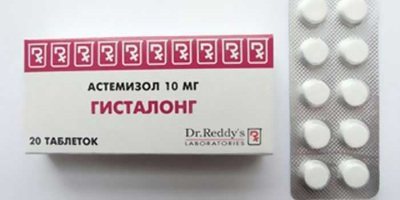
The antiserotonin effect is weakly expressed. Anticholinergic and sedative effects are not observed. The therapeutic effect lasts for 48 - 72 hours. The maximum concentration of astemizole is observed 2 - 3 hours after the first use.
Indications for use:
- Quincke's edema;
- rashes on the skin of an allergic type;
- runny nose (including seasonal);
- bronchial asthma.
Contraindications include:
- liver failure;
- childhood;
- the period of bearing a child and breastfeeding;
- calcium deficiency;
- simultaneous use with other antiallergic drugs.
Release form: tablets. They must be taken on an empty stomach, 2 - 3 hours after eating. The daily norm for adults and adolescents is no more than 1 tablet per day. The course of application should not exceed 7 days.
Claritin
Claritin is a third-generation antiallergic drug that contains loratadine.
Additional elements include:
- vegetable starch;
- magnesium salts of stearic acid;
- milk sugar.
Release form: suspension and syrup. The drug has antiallergic, antihistamine and antipruritic effects, selectively blocking peripheral receptors. The patient feels relief after 25-30 minutes. after the first dose of the drug.
The active component is not able to cross the blood-brain barrier and has no effect on the nervous system. Claritin does not have a sedative effect.
The drug is prescribed for the following pathologies:
- rashes on the skin caused by allergies;
- hives;
- conjunctivitis or allergic-type runny nose.
The drug has a minimum of contraindications.
These include:
- hypersensitivity;
- breastfeeding period;
- childhood.
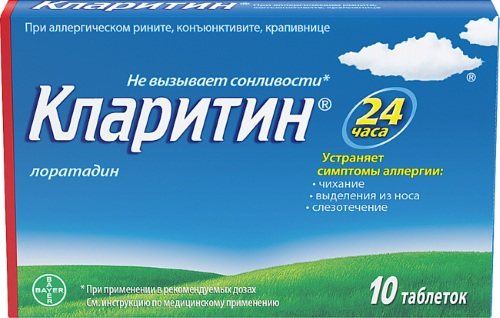
Claritin tablets
Side effects appear as:
- short-term alopecia;
- dry mouth;
- rapid fatigue.
Children over 2 years of age are most often prescribed syrup. The dosage is determined individually, taking into account the child’s weight. The second dosage form can be taken by adolescents and adults. The daily dose is 10 mg, which is equivalent to 1 tablet. The course of application is 4-7 days.
Suprastin
Suprastin goes on sale in the form of tablets and injection solution. The main component is chloropyramine (an analogue of tripelenamine). The action of the antiallergic drug is aimed at preventing the development of hyperreactions and stopping the release of histamine into cells.
The instructions contain the following indications:
- anaphylactic shock;
- angioedema;
- conjunctivitis, allergic rhinitis;
- serum sickness;
- hay fever;
- hives.
For hyperthermia, Suprastin can be taken simultaneously with No-Shpa. The drug is included in complex therapy for otitis and sinusitis.
Contraindications:
- intolerance to the ethylenediamine component;
- disturbance of urine outflow;
- prostatitis;
- myocardial infarction;
- tachycardia, arrhythmia;
- simultaneous use with MAO inhibitors;
- angle-closure glaucoma;
- ulcerative lesions of the stomach and duodenum;
- asthma.
If the dosage regimen is incorrectly selected, the risk of side effects is quite high.
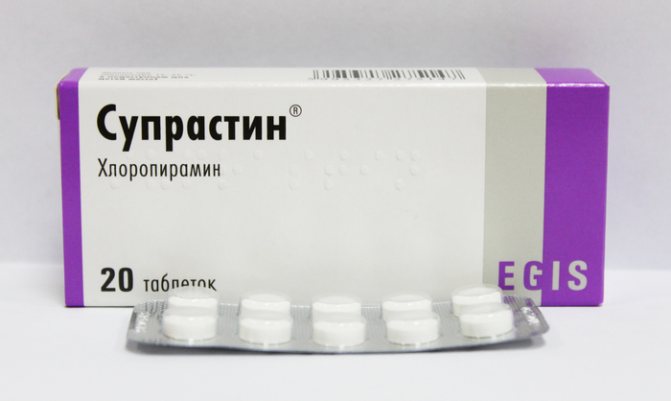
These include:
- tremor;
- ataxia;
- drowsiness;
- fatigue;
- headache;
- tachycardia;
- surges in blood pressure.
Suprastin is not prescribed for children. The daily norm for adults is 2 tablets per day. The course of application is up to 5 days. The injection solution is administered intramuscularly in emergency cases with the development of angioedema.
Tavegil
The active ingredient in Tavegil is climastin in the form of hydrofumarate. The drug is marketed in the form of tablets or solution for injection. Additional components vary depending on the release form.
The drug is characterized by a pronounced antipruritic and decongestant effect. The main component slows down the process of edema formation, reducing capillary permeability.
No carcinogenic, mutagenic or torratogenic effects were identified during the studies. A drug. Does not reduce fertility when used in reasonable doses. Tavegil is prescribed for various allergic reactions.
It can be taken by people suffering from:
- contact dermatitis;
- dermatosis;
- rhinitis;
- hay fever;
- hives;
- hemorrhagic type vasculitis.

It is not recommended to take medications during pregnancy and breastfeeding. The drug is contraindicated in hypersensitive people.
Other contraindications:
- pathologies of the heart and blood vessels;
- prostatitis;
- arterial hypertension;
- obstruction of the bladder and cervix;
- bronchial asthma.
If the therapeutic norm is exceeded by 2-3 times, the patient may experience insomnia and prolonged migraine. Side effects most often disappear on their own after 2-3 days of regular use.
The tablets are taken twice a day. The daily intake should not exceed 6 mg. Intramuscular and intravenous administration is carried out up to 2 times a day. The drug has no age restrictions.
Ketotifen
Ketitofen is a third-generation antiallergic drug, which contains the active substance of the same name in the form of fumarate. The medication comes in several forms, including tablets, syrup and eye drops. It has a pronounced antihistamine effect, slowing down the process of release of organic compounds and inhibiting the phosphodiesterase enzyme.
The drug is prescribed for rhinitis, allergic conjunctivitis and bronchial asthma.
The following are considered contraindications:
- the period of bearing a child and breastfeeding;
- intolerance to the main component.
The tablets are taken twice a day. The course of treatment should not exceed 7 days. The therapeutic norm of syrup for children is 0.25 ml/kg. Eye drops are prescribed for allergic conjunctivitis (1 drop twice a day).
Allegra
The drug does not have a sedative effect even with prolonged use. The composition contains fexofenadine (180 or 120 mg). Release form: tablets for adults and children. The second preparation contains 30 mg of fexofenadine.
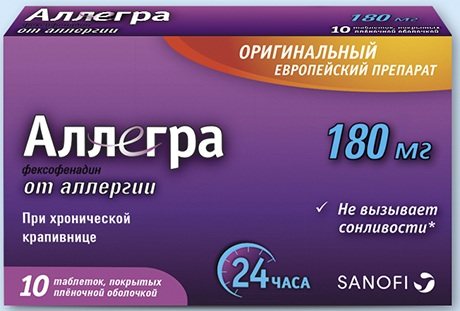
Indications for use:
- urticaria of the idiopathic type of chronic course;
- seasonal rhinitis.
Contraindications:
- individual intolerance;
- children's age (up to 6 years);
- period of breastfeeding and childbearing.
The drug has a number of relative restrictions on use.
These include:
- pathologies of blood vessels and heart;
- elderly age;
- renal and/or liver failure.
Tablets are taken 1-2 hours before meals. The daily dose for adults and children is 120 mg/30 mg (adult/child).
Erius
Erius is an antihistamine that does not cause addiction or drowsiness. It goes on sale in the form of syrup and tablets. The drug is characterized by a pronounced antiallergic effect, which is achieved due to the ability of the main component to suppress hyperreactions of inflammation caused by the allergen.
The tablets contain the following components:
- starch;
- wax;
- cellulose;
- desloratadine;
- macrogol.
Syrup composition:
- desloratadine;
- flavoring;
- sorbitol;
- purified water;
- citric acid.
The drug is prescribed to reduce itching and rash. It is effective for rhinitis, hay fever, rhinorrhea and urticaria.
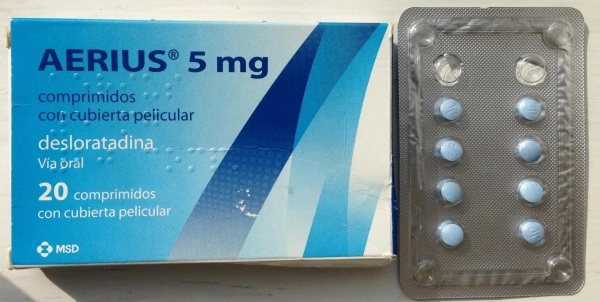
Aerius tablets
The following are considered contraindications:
- children's age (up to 12 years);
- pathologies transmitted by inheritance;
- fructose and glucose intolerance;
- renal failure.
The syrup is prescribed to children from 6 months. The daily norm is no more than 2.5 ml. Children over 6 years old are given 5 ml, teenagers - 10 ml. Adults can take 1 tablet per day. The course of treatment is 5-7 days.
Third generation antihistamines
Second-generation drugs have virtually no effect on the functioning of the nervous system, which eliminates the hypnotic effect. However, as noted above, their use is associated with the risk of serious cardiac effects, which significantly limits their use for people with heart problems. To eliminate this drawback, third generation antihistamines have been developed.
What advantage do these tools have over earlier developments? These medications are among the most advanced drugs in which cardiotoxic and sedative effects are excluded. They can be safely prescribed to drivers and people whose profession is associated with accelerated reaction, accuracy and attentiveness. They are somewhat more expensive than the above-mentioned tablets, but are highly effective.

To combat allergies, the following third generation antihistamines are recommended:
- Telfax. Its basis is the active ingredient - fexofenadine. Tablets of this type are considered the safest in terms of possible side effects. They are most effective for allergic rhinitis and skin lesions (urticaria). It is recommended to prescribe to children at least 10 years old.
- Zirtec, Cetrin. The drugs are based on cetirizine. They are useful for rhinitis and conjunctivitis, both seasonal and permanent; dermatoses and urticaria; angioneurotic edema. The effect of the medications begins quickly, and after 1.5-2 hours you can notice a positive result, while the duration of protection lasts 22-25 hours.
- Histamanal. Contains the antiallergen astemizole. Particularly effective for skin manifestations and runny nose. Able to maintain its effect from 15 to 25 hours, depending on the individual characteristics of the body. When taking this drug, it is extremely rare, but it is possible to increase heart rate and increase appetite.
- Trexyl. The active substance is terfenadine. It is used for almost any manifestation of allergies, incl. for asthmatic reactions. To avoid side effects, the medicine should not be combined with foods and drinks containing ethanol. Particular care must be taken when choosing the dosage of the drug.
- Xizal. The drug has a wide spectrum of targeting and prolonged action.
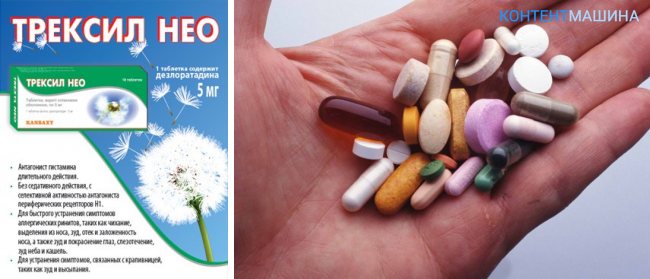
Cost of drugs
The approximate cost of the above medications is shown in the table:
| Name | Price |
| Tsetrin | From 180 rub. |
| Gistalong | From 220 rub. |
| Claritin | RUB 20,160 |
| Suprastin | From 180 rub. |
| Tavegil | From 250 rub. |
| Ketitofen | From 170 rub. |
| Allegra | From 360 rub. |
| Erius | From 200 rub. |
You cannot select a drug on your own based on its cost. Self-medication, without establishing an accurate diagnosis, can provoke the development of complications.
Antiallergic medications must be taken according to instructions. Drugs that do not cause drowsiness do not affect the speed of reactions in any way, so the patient can drive a car during the treatment period. This category of medications does not require a prescription at the pharmacy.
Laboratory diagnostic methods
The disease can manifest itself in different ways, so laboratory tests are used to clarify the diagnosis. Among the main methods of laboratory research are the following:
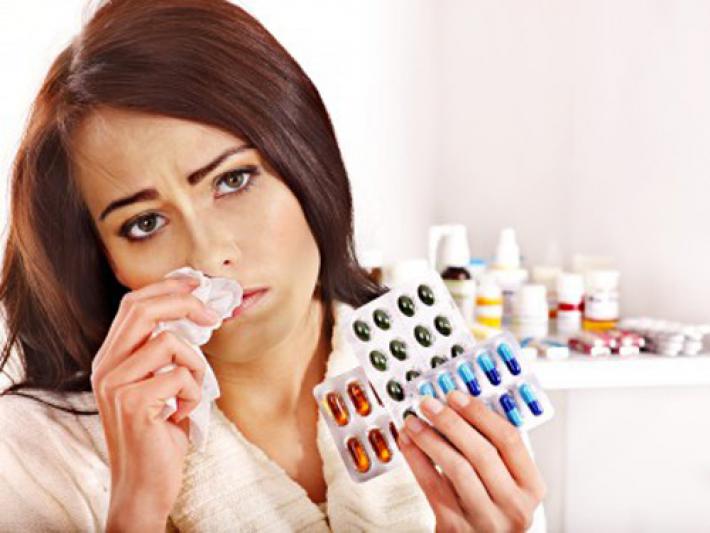
Radiosorbent method: determination of drug-specific immunoglobulins.- Enzyme-linked immunosorbent method: detection of immunoglobulins specific to the substances under study.
- Modifications of the Shelley test.
- Study of the reaction to the rate of inhibition of leukocytes and their blast transformation.
- Test for the release of potassium ions and sulfidoleukotrienes.
- Chemiluminescence.
In the CIS countries, doctors most often use the enzyme immunoassay method. It is suitable for use in most modern laboratories. This method is safe for the patient, but is regulated because the reagents are expensive.
The first method (radiosorbent) is recommended for possible allergies to antibiotics, acetylsalicylic acid or gentamicin. To conduct such a study, the patient's blood serum is used. Analyzes are carried out within 24 hours. A distinctive feature of this method is its information content.
The fluorescent method has been tested for ninety drugs. The patient's blood is used to conduct the study. This test takes about half an hour. Its advantage is the need for a small volume of blood (about one hundred microliters for one test).
The leukocyte inhibition test has been used in the CIS countries since the eighties of the last century. From a technical point of view, this test is very simple, so it can be performed in any medical institution. It is most often used to detect allergies to non-steroidal drugs and antibiotics. Among its advantages, it is worth highlighting its low cost. It takes one and a half hours to conduct drug sensitivity tests. However, this method can both help the patient and harm, and therefore it is not recommended to use it for patients under six years of age or if there are acute allergic diseases.
Use of provocative tests
The main task of a provocative test is to identify the allergen by creating a provocation. To do this, the possible allergen is introduced in the form of a liquid. If signs of allergy appear, this means that the test has a positive reaction.
A provocative test is done if other methods fail to identify the allergen . The purpose of the procedure is to identify allergens and select the correct treatment. In addition, with the help of accurate diagnosis, it is often possible to convince the patient to make efforts to prevent contact with allergens. As a result, your health improves.
You can do no more than one provocative test per day. Such a study is contraindicated in cases where:
- The main or concomitant disease is in the acute stage;
- The underlying disease gave complications;
- There are other diseases not related to the main illness, which are also in the acute stage;
- There is an exacerbation of chronic infectious diseases;
- A high degree of sensitivity to the allergen is detected;
- There are signs of kidney dysfunction.
Also, such a study is not recommended for the following diseases:
- For active tuberculosis and acute inflammatory processes.
- If there is second degree pulmonary insufficiency.
- With rheumatism in the active stage.
In addition, such studies are contraindicated in pregnant women.
